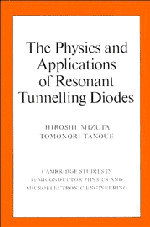Book contents
- Frontmatter
- Contents
- Preface
- 1 Introduction
- 2 Introduction to resonant tunnelling in semiconductor heterostructures
- 3 Scattering-assisted resonant tunnelling
- 4 Femtosecond dynamics and non-equilibrium distribution of electrons in resonant tunnelling diodes
- 5 High-speed and functional applications of resonant tunnelling diodes
- 6 Resonant tunnelling in low-dimensional double-barrier heterostructures
- Index
4 - Femtosecond dynamics and non-equilibrium distribution of electrons in resonant tunnelling diodes
Published online by Cambridge University Press: 26 January 2010
- Frontmatter
- Contents
- Preface
- 1 Introduction
- 2 Introduction to resonant tunnelling in semiconductor heterostructures
- 3 Scattering-assisted resonant tunnelling
- 4 Femtosecond dynamics and non-equilibrium distribution of electrons in resonant tunnelling diodes
- 5 High-speed and functional applications of resonant tunnelling diodes
- 6 Resonant tunnelling in low-dimensional double-barrier heterostructures
- Index
Summary
Following the study in Chapter 3 of the effects of elastic and inelastic scattering on the transmission probability function, this chapter investigates non-equilibrium electron distribution in RTDs. Electron distribution in the triangular potential well in the emitter is studied first (Section 4.1). Then dissipative quantum transport theory is presented based on the Liouville–von-Neumann equation for the statistical density matrix (Section 4.2.1). Numerical calculations are carried out in order to analyse the femtosecond dynamics of the electrons (Section 4.2.2) and the dynamical space charge build-up in the double-barrier structure which gives rise to the intrinsic current bistability in the NDC region (Section 4.3.1). Next experimental studies of the charge build-up phenomenon are presented using magnetoconductance measurements (Section 4.3.2) and photoluminescence measurements (Section 4.3.3). Finally, the effects of magnetic fields on intrinsic current bistability are studied (Section 4.4).
Non-equilibrium electron distribution in RTDs
Let us start with a discussion on electron distribution in the emitter. We have seen in Section 2.4 that the electronic states in the emitter become 2D in the pseudo-triangular potential well formed between the thick spacer layer and the tunnelling barrier (see Fig. 2.16). Sharper current peaks observed for Materials 2 and 3 (Fig. 2.18) have been attributed to the 2D–2D nature of resonant tunnelling. This interpretation is based upon an assumption that the electrons in the triangular well are well thermalised, and that local equilibrium is achieved.
- Type
- Chapter
- Information
- The Physics and Applications of Resonant Tunnelling Diodes , pp. 88 - 132Publisher: Cambridge University PressPrint publication year: 1995



